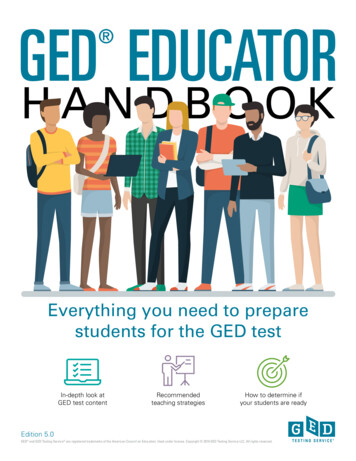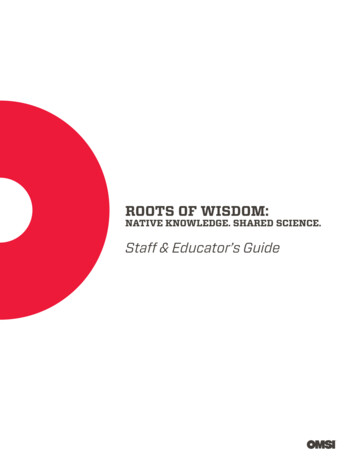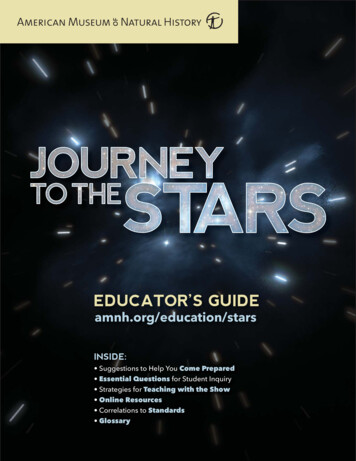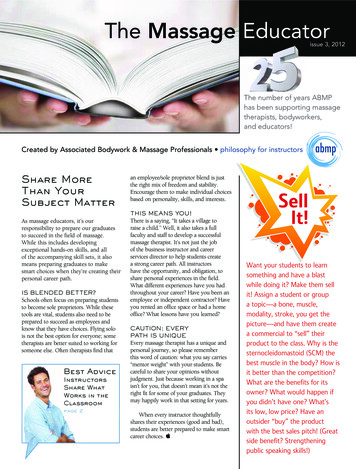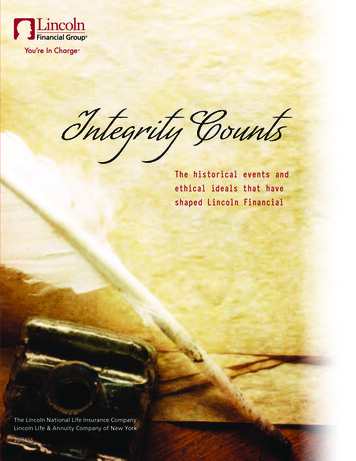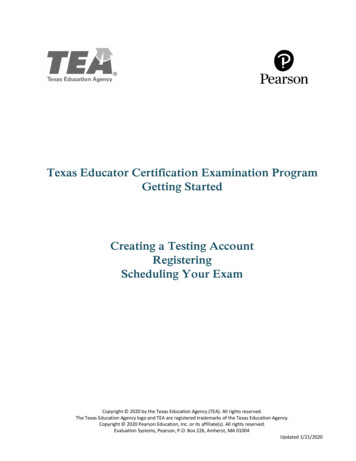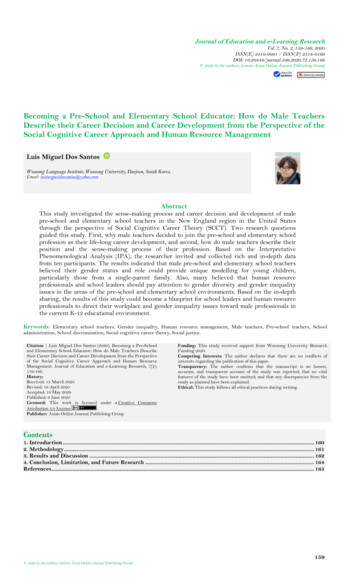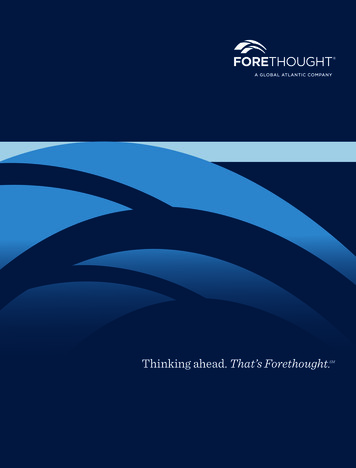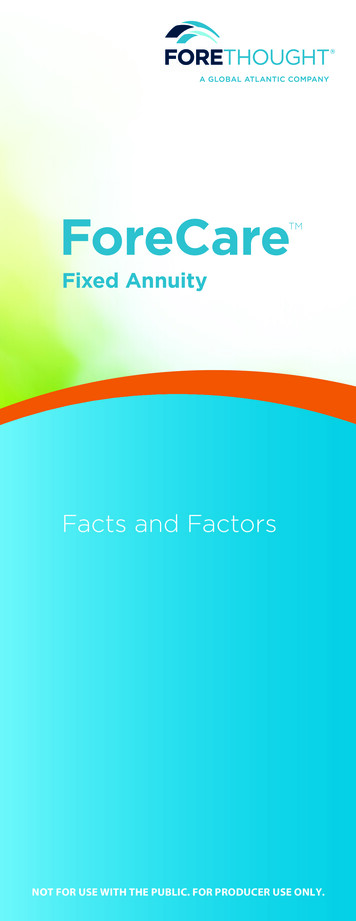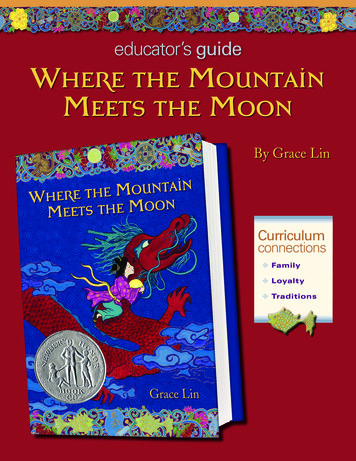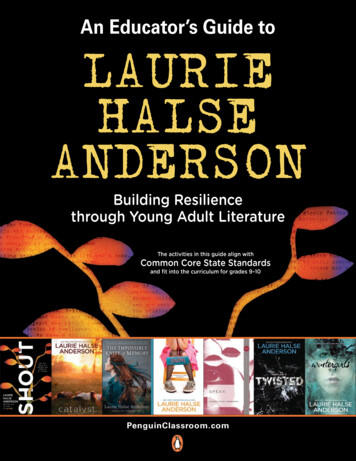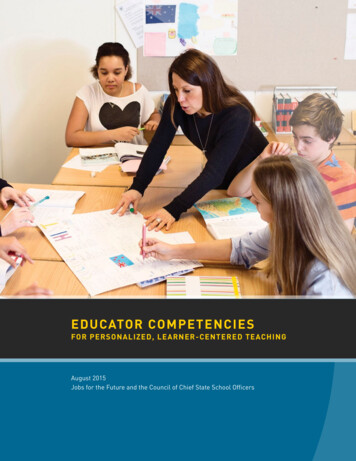
Transcription
EDUCATOR COMPETENCIESFOR PERSONALIZED, LEARNER-CENTERED TEACHINGAugust 2015 By Cecilia Le, Rebecca E. Wolfe, and Adria SteinbergJobs for the FutureJobs forandthetheFuture,CouncilSeptemberof Chief State2014School OfficersJOBS FOR THE FUTURE AND THE COUNCIL OF CHIEF STATE SCHOOL OFFICERSi
ACKNOWLEDGEMENTSThe primary authors of this document, Rebecca E. Wolfe, Director, Students at the Center (JFF) and Jennifer Davis Poon,Director, Innovation Lab Network (CCSSO) wish to acknowledge the close to one hundred individuals who gave so willinglyof their expertise and time to make these Competencies as complete, accurate, and useful as possible for this version.As this undertaking grew in scope and depth, so too did the contributions of the “Competency Dream Team” steeringcommittee which includes: Carmen Coleman, Next Generation Leadership, Center for Innovation in Education; Jean Garrity,Associate Director, the Institute for Personalized Learning at CESA #1; and Eve Goldberg, Director of Research, the NellieMae Education Foundation. We are deeply grateful to this group for their project, guidance, advice, developmental editing,meeting facilitation, and collaboration throughout the entire process. Despite all of this invaluable help, all errors hereinare attributable only to the authors.In addition, Rebecca would like to acknowledge the contributions from members of the Students and the Center teamand JFF including: Adria Steinberg, Vice President, Sarah Hatton, Program Manager, Carol Gerwin, Writer/Editor, andSophie Besl, Communications Manager. She also thanks Chiranit Prateepasen for graphic design. Jennifer would like toacknowledge the contributions from CCSSO colleagues including: Saroja Barnes, Program Director, Education Workforce;Holly Boffy, Program Director, Education Workforce; and Adriana Martinez, Senior Associate, Innovation Lab Network.Jobs for the Future is a national nonprofit that works to ensureThe Council of Chief State School Officers (CCSSO) is a nationwide,educational and economic opportunity for all. We developnonpartisan, and nonprofit membership organization committed toinnovative career pathways, educational resources, and publicsupporting state education leaders as they build public educationpolicies that increase college readiness and career success,systems that prepare every child for college, careers, and life. Withinand build a more highly skilled workforce. With over 30 years ofCCSSO, the Innovation Lab Network (ILN) is a group of leadingexperience, JFF is the national leader in bridging education andstates taking action to identify, test, and implement student-centeredwork to increase mobility and strengthen our economy. JFF’sapproaches to learning that will transform our public educationStudents at the Center initiative synthesizes and adapts forsystem. Schools and districts within ILN states have been given thepractice current research on key components of student-centeredopportunity to act as pressure-testers of new and innovative ways toapproaches to learning that lead to deeper learning outcomes.achieve deeper learning outcomes for every student, with backingOur goal is to strengthen the ability of practitioners andand support from their state departments of education. In thepolicymakers to engage each student in acquiring the skills,context of the ILN, CCSSO acts as a centralizing entity that facilitatesknowledge, and expertise needed for success in college, career,a learning community among state leaders while also providingand civic life.individual support to ILN states as they advance their ILN agendas.WWW.JFF.ORGWith key partners including the Center for Innovation in Education,CCSSO provides critical leadership as states move forward with theirinnovative efforts.WWW.CCSSO.ORGSuggested citationJobs for the Future & the Council of Chief State School Officers. 2015. Educator Competencies for Personalized, Learner-CenteredTeaching. Boston, MA: Jobs for the Future.This project is supported generously by funds from the Nellie Mae Education Foundation.JOBS FOR THE FUTURE AND THE COUNCIL OF CHIEF STATE SCHOOL OFFICERSiii
ivEDUCATOR COMPETENCIES FOR PERSONALIZED, LEARNER-CENTERED TEACHING
Table of ContentsINTRODUCTION1Guiding principles3Why a new framework?4Who should use this framework and how?4Where do we go from here?5THE EDUCATOR COMPETENCIES FOR PERSONALIZED, LEARNER-CENTERED TEACHING6Cognitive Domain8Intrapersonal Domain10Interpersonal Domain13Instructional Domain16APPENDIXA: Glossary of Terms20B: Methodology27C: Source Frameworks28D: Crosswalk of InTASC Model Core Teaching Standards to Educator Competencies forPersonalized, Learner-Centered Teaching29E: Selected Resources from Students at the Center44ENDNOTES47JOBS FOR THE FUTURE AND THE COUNCIL OF CHIEF STATE SCHOOL OFFICERSv
viEDUCATOR COMPETENCIES FOR PERSONALIZED, LEARNER-CENTERED TEACHING
IntroductionAs college- and career-ready standards become a reality across the nation,educators and system leaders are increasingly exploring new models ofteaching and learning that are more responsive to the needs of all students inour elementary and secondary schools. Known as learner-centered, studentcentered, or personalized learning these approaches require a rethinking of theteaching and learning practices that have predominated public school instruction.See Appendix A for a glossary of highlighted words.Gone is the default image of a teacher—an adult lecturing tostudents seated neatly in rows, assigning the same textbookpages to everyone, and administering the same quiz onthe same day to the entire class, with the expectation ofa “normal distribution” of achievement along a bell curve.Instead, teachers in personalized, learner-centered settingsare called upon to assess and address individual studentneeds and help all reach rigorous proficiency standards.These educators promote collaborative work amonggroups of students; integrate learning experiences thatoccur outside the classroom; and, above all, foster learnerindependence and student voice and choice, or studentagency. Achieving this ambitious vision is only possible withsignificant changes in the very role of the educator and theways in which educators interact with students, peers, andthe broader community.Learner-centered approaches have captured theimagination and loyalty of educators since the time ofDewey and the Progressive Movement, yet they havenever been implemented at scale. What marks this eraas any different? The renewed interest in personalized,learner-centered education today builds from a powerfulcombination of economic, scientific, egalitarian, andtechnological forces: We have a better understanding ofwhat truly constitutes college and career readiness for anever-changing, global marketplace. Cognitive neuroscienceand learning theory research reveal close connectionsamong motivation, agency, and learning. For the firsttime in our history, the nation is committed to preparingall students for success in postsecondary educationA NOTE ABOUT KEY EDThe language used to name theeducational approaches that are thefocus of these Competencies hasevolved rapidly over the past fewyears. Due to recent shifts in meaning,our organizations increasinglyuse the terms student-centered,learner-centered, and personalizedas largely interchangeable in ourliterature. For the purposes of theseCompetencies, we have decidedto use one consistent phrase—“personalized, learner-centered,”which we believe best captures thespirit of approaches that build onthe learner’s needs and interests,regardless of age. By contrast,student-centered can be used in somecontexts to indicate only learners ina K-12 system, rather than learnersat any educational stage or setting.Similarly, personalized by itself can beused to place a special emphasis onthe use of technology, rather than onmultiple instructional strategies.For more on the language of thisemerging field, please see theaccompanying glossary and sourcessuch as: Students at the Center’sFAQs, iNACOL’s Mean What YouSay report, and this blog by NextGeneration Learning Challenges.JOBS FOR THE FUTURE AND THE COUNCIL OF CHIEF STATE SCHOOL OFFICERS1
Introductionand careers. And the rapid expansion of technological advances and availability makes a level ofpersonalization possible at scale as never before.Given the pace and scope of these changes, many educators find themselves tackling challenges forwhich they are not fully prepared and devoting immeasurable energy to learning “on the fly” andon their own. Some noteworthy online and in-person professional development opportunities haveemerged to support personalized, student-centered approaches.i Nonetheless, state and local teacherpreparation and professional development systems across the country still do relatively little toadvance abilities to deliver these approaches—nor have such competencies been defined in ways thatsystem leaders can act upon them.DEFINING AND BUILDING A KNOWLEDGE BASE FOR LEARNER-CENTERED APPROACHESMultiple frameworks and research studies now identify an increasingly coherent set of knowledge, skills,and dispositions students need to succeed in the 21st century. Since 2010, Students at the Center has beenworking with academics and researchers to compile, synthesize, and analyze hundreds of research articlesto develop a grounded definition of student-centered learning.ii The four key principles of student-centeredlearning—drawn from the mind/brain sciences, learning theory, and research on youth development—areoverlapping and complementary. They are: Learning is personalized Learning is competency based Learning takes place anytime, anywhere Students have agency and ownership over their learningIn combination, and when guided by a coherent and rigorous set of educational goals, these principlesprovide a strong foundation for the pursuit of deeper learning — the knowledge, skills, and dispositionsnecessary to prepare every student for college, career, and civic life.A small but growing group of studies following the release of the Students at the Center framework providesfurther substantiation for this vision (e.g., Zeiser et al. 2014; Pellegrino & Hilton 2012).iiiEvery school and district that shares this vision will use different techniques to translate student-centeredprinciples into practice. Some schools will move to a fully project-based curriculum; others will have anIndividual Learning Plan for each student. However, all such settings share a commitment to: 1.) reachhigh-quality implementation across the four key principles; 2.) achieve the goals of college, career, and civicsuccess for all students; and 3.) focus on building communities of educators with the skills outlined in thisdocument.The development of Educator Competencies for Personalized, Learner-Centered Teaching (“theCompetencies”) serves as a first step in identifying the knowledge, skills, and dispositions thateducators need in order to create and thrive in effective personalized, learner-centered environments.The Competencies are organized into four domains—Cognitive, Intrapersonal, Interpersonal, andInstructional. For each domain, we identified both high-level competencies and detailed “indicators,”which describe specific ways that educators can meet each competency in a personalized, learnercentered manner.2EDUCATOR COMPETENCIES FOR PERSONALIZED, LEARNER-CENTERED TEACHING
The lead contributors to this effort consisted of a group of national and state partners focused onincreasing educational achievement for all: Jobs for the Future’s Students at the Center initiative, theCouncil of Chief State School Officers’ Innovation Lab Network, the National Center for Innovationin Education at the University of Kentucky, the Institute@CESA#1 in Wisconsin, and the Nellie MaeEducation Foundation. The partners solicited and received feedback from nearly 100 school, district,and state innovators, researchers, and thought leaders from across the country. (See Appendix B for asummary of the methodology used to develop these Competencies.)Guiding principlesThroughout the research and writing process, we faced many difficult decisions about what theCompetencies should include and how best to organize them. Together with our partners andadvisors, we arrived at a number of key principles to guide and inform our work and perspective.We determined that the Competencies should: Be embedded within a holistic educational vision and supported by a school culture—includingprofessional development, curricular freedom, and other structures—to ensure their success.We recognize that many obstacles beyond teachers’ control must be cleared in order to realizesuccess in most or all of the Competencies. The Competencies are designed first and foremostto inform practitioners who work in school systems that are already making innovative, learnercentered reforms. Be applied to groups of educators or whole school teams. We recognize that, taken as a whole,the full set of Competencies is aspirational. In our vision, no individual educator would be expectedto have mastered all of these skills and be able to demonstrate each one flawlessly at any singlemoment in time. Our intent, in no way, is to ask teachers to “do more with less.” Rather, we arecalling for schools, districts, and states to “do differently.” Align with similar efforts to describe student competencies, system leader competencies, andsystem characteristics for deeper learning. Our description of the innovative, learner-centerededucator is aligned with complementary efforts to describe the competencies that students needfor deeper learning, the competencies that administrators need to lead personalized, learnercentered schools and districts, and the regulations and policies needed to support these efforts atscale and over time. Convey a firm and explicit commitment to equity. These competencies describe the kinds ofcapabilities educators need to succeed with all learners, of any socio-economic background, race,ethnicity, skill level, learning disability, or culture. They are compiled from research, practice, andevidence that cross these categories. Wherever applicable, we make this commitment transparent. Focus on knowledge, mindsets, and skills that go beyond general “good teaching” practicesto emphasize areas that comprise successful approaches in personalized, learner-centeredsettings. Many existing standards and frameworks for educator development include “goodteaching” practices that are applicable in all settings. Rather than reiterate these fundamentals,JOBS FOR THE FUTURE AND THE COUNCIL OF CHIEF STATE SCHOOL OFFICERS3
Introductionthis framework highlights the specific competencies that are most applicable—and essential—to thedistinct context of personalized, learner-centered environments. Not be read as progressions or prioritized until further research can be conducted. We donot currently have enough information about implementation of personalized, learning-centeredapproaches to prioritize the domains, or outline a progression for training in the competencies.Our organizations, state partners, and others will be pursuing the development of such tools asthe work continues and further field testing is conducted.Why a new framework?This is the first attempt to specifically and comprehensively identify a set of competencies foreducators striving to move beyond our legacy system and practices in order to transition topersonalized learning environments. At the same time, we recognize the value and substance ofother more well-established frameworks, such as The Danielson Group’s Framework for Teaching, anearly innovator describing high-quality teaching for learning; and The Interstate Teacher Assessmentand Support Consortium (InTASC), which produced a comprehensive set of Teacher Standards thatpoint the way for states to evaluate excellence in teaching. Some of the individual competencies,particularly in the Cognitive Domain, build directly on these foundational efforts. We also incorporatedsome of most relevant components from newer frameworks, such as The International Associationfor K-12 Online Learning (iNACOL)’s Blended Learning Teacher Competency Framework. (See AppendixC for the complete list of educator frameworks scanned and synthesized for this project.) Yet theCompetencies and the accompanying Indicators are the only complete educator vision designed for alearner-centered setting, thereby setting this undertaking apart.Furthermore, in contrast to teacher standards (such as InTASC), which are high-level statementsof what teachers should know and be able to do, the Competencies offer an interpretation of howto translate standards within the context of personalized, student-centered learning models. (SeeAppendix D for a crosswalk between the Competencies and the InTASC standards.)We hope the similarities between the Competencies and other frameworks provide a sense offamiliarity and respect for the practices of many talented teachers out in the field. A personalized,learner-centered education approach does not throw out previously gained knowledge and evidenceof good teaching and learning. Far from it. Instead, this framework deliberately builds a bridge fromthose foundations toward a vision of how the teaching profession can evolve to meet the changingneeds of learners.Who should use this framework and how?As noted above in our Guiding Principles, we developed these Competencies for school systemsalready making bold strides to implement personalized, learner-centered approaches. We designedthem in collaboration with these innovators to help support their efforts to develop new educationmodels that strive for college and career readiness for all.4EDUCATOR COMPETENCIES FOR PERSONALIZED, LEARNER-CENTERED TEACHING
Our intent is for this framework to serve as a “living” tool to guide educator development, so thata growing number of teachers are able to help scale the transformation to personalized, studentcentered learning. To that end, the Competencies, will be available in a digital format on the webthis fall. This format will enable us to continue to improve and tighten the Competencies as they arepiloted and additional feedback is gathered. Within schools, practitioners may want to utilize thecompetencies for self-assessment, quality improvement, professional development, hiring decisions,and culture reinforcement. In addition, with appropriate stakeholder engagement and ongoingresearch, district and state leaders may find the competencies useful in informing their effortsto develop teachers, such as through the design of educator standards, licensure requirements,preparation program curricula, induction processes, or educator effectiveness systems.Where do we go from here?We recognize that defining personalized, learner-centered competencies is only one piece of acomplex puzzle. We cannot expect educators to achieve these Competencies at any scale or levelof sustainability without supportive policy, communication, school structures, school leaders, andprofessional development. Nor can they be adopted in the current form without piloting, evaluation,guidance, training, and improvement.Fortunately, steps are underway to start to address these many challenges. Several organizationshave recently released papers or are embarking on efforts to rethink how we train, recruit, support,and deploy educators—including school leaders—in order to achieve a workforce capable of meetingstudents’ current and future needs.ivWe will follow the release of this list with a two-phase implementation plan. These additional effortswill make the competencies more practical, digital, and sustainable (e.g., by adding a video andexemplar database, and exploring potential use in teacher preparation, certification, and support).First, we are convening a meeting of policymaker and implementer teams
approaches to learning that lead to deeper learning outcomes. Our goal is to strengthen the ability of practitioners and policymakers to engage each student in acquiring the skills, knowledge, and expertise needed for success in college, career, and civic life. WWW.JFF.ORG The Counci

